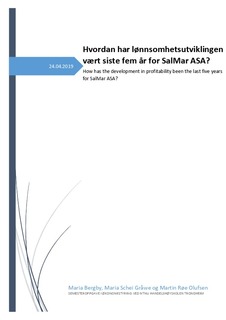| dc.contributor.advisor | Olsen, Tor-Eirik | |
| dc.contributor.author | Bergby, Maria | |
| dc.contributor.author | Gråwe, Maria Schei | |
| dc.contributor.author | Olufsen, Martin Røe | |
| dc.date.accessioned | 2019-06-17T14:00:35Z | |
| dc.date.available | 2019-06-17T14:00:35Z | |
| dc.date.issued | 2019 | |
| dc.identifier.uri | http://hdl.handle.net/11250/2601093 | |
| dc.description.abstract | Sjømatsektoren kommer til å spille en viktig rolle i å sikre fremtidens velferd i Norge. SalMar er en av de største innen denne sektoren, og vi har derfor sett på hvordan lønnsomhetsutviklingen har vært for trønderbedriften i femårsperioden fra 2013-2017. SalMars inntekter er sterkt påvirket av valutakurs- og lakseprisutviklingen. En svekket norsk krone opp mot euroen, og en økning i lakseprisen i denne perioden, tyder på at også inntektene har økt. Likevel er det mulig at denne positive effekten nøytraliseres på grunn av tilsvarende økte kostnader andre steder i verdikjeden. Dette undersøkte vi nærmere i vår analyse.
I analysen av lønnsomhetsutviklingen har vi sett på regnskapstall hentet fra Proff Forvalt for perioden 2013-2017. Først så vi på bedriftens finansiering, soliditet og likviditet, og delvis litt om hvorfor de har endret seg. Deretter analyserte vi lønnsomheten til SalMar og sammenlignet med fire andre bedrifter i samme bransje.
SalMars finansiering har hatt en negativ utvikling i løpet av perioden, men er likevel godt innenfor hva som normalt kreves. Langsiktig lagerfinansiering har sunket, mens finansieringsgrad 1 har økt. Videre viser analysene at soliditeten til SalMar er meget robust. Egenkapitalandelen, gjeldsgraden og rentedekningsgraden har alle hatt en positiv utvikling i løpet av perioden. SalMars likviditet har derimot svekket seg i løpet av perioden. Likviditetsgrad 1 og arbeidskapitalen har vært svakt fallende, men likevel tilfredsstillende isolert sett. Likviditetsgrad 2 har også sunket, og ligger et godt stykke under det ønskelige nivået.
Lønnsomheten til SalMar er jevnt over svært god sammenlignet med lønnsomheten til de andre bedriftene i analysen. Her kan man spesielt trekke fram resultatgraden, driftsmarginen og fortjenesteprosent som nøkkeltall hvor SalMar skiller seg ut. Ser man perioden under ett har lønnsomhetsutviklingen for SalMar vært forholdsvis flat, og den ser ut til å være stabilt høy over tid. Påvirkningen fra valutakurs- og lakseprisutviklingen er de mest sannsynlige årsakene til at vi ser en viss samvariasjon mellom bedriftenes lønnsomhet. | |
| dc.description.abstract | The seafood industry will most likely play an important part in securing the future welfare of Norway. SalMar is one of the largest companies in this industry, and we have analyzed how the development of SalMar’s profitability has been in the period 2013-2017. The revenues of SalMar are highly influenced by the development of the salmon price and the exchange rate between NOK and EUR. During this period the NOK has weakened compared to the EUR and the salmon price has increased, which indicates that revenues have gone up. Nevertheless, it is still possible that this positive effect has been offset by a corresponding increase in costs in other parts of the value chain. We have looked closer into this in our analysis.
In the analysis of the development of the profitability we have investigated the accounting figures gathered from Proff Forvalt for the relevant period. We have analyzed SalMar’s financing, solidity, and liquidity. Then we analyzed the profitability of SalMar and compared with four major competitors within the same industry.
The financing of SalMar has had a negative development throughout the period, but it is still within what is normally considered good. The long-term stock financing has decreased, while the funding ratio has increased. Further, our analysis shows that the solidity of SalMar is very good. The equity ratio, gearing ratio and interest-coverage ratio have all had a positive development throughout the period. On the other hand, the liquidity of SalMar has been weakened during the period. The current ratio and working capital have been gradually decreasing, but they are still satisfying when evaluated individually. The quick ratio has also been falling and is quite a bit under the desired level.
The profitability of SalMar has generally been superb compared to the profitability of the other companies in the analysis. SalMar particularly exceed the other companies when looking at the profit margin, operating margin, and net profit margin. When evaluating the whole period, it seems the development of SalMar’s profitability has been relatively flat, and it seems to be high and stable over time. The impact from changes in the exchange ratio and salmon price seem to be the most likely reasons for seeing a certain correlation between the companies’ profitability development. | |
| dc.language | nob | |
| dc.publisher | NTNU | |
| dc.title | Hvordan har lønnsomhetsutviklingen vært siste fem år for SalMar ASA? | |
| dc.type | Bachelor thesis | |
